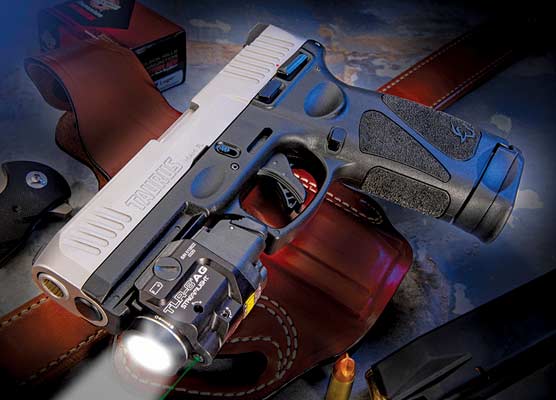To Sight Or Not To Sight
Historically, the issue of using the sights on a handgun is discussed calmly to a point of which technique is better — aimed fire or pointed fire. After opening remarks are proffered it generally deteriorates into an ugly, name-calling, verbal brawl by proponents for each technique and is argued to a draw — at least in each proponent’s eyes.
Aimed Fire
Sight alignment is described as the proper alignment of the front to the rear sight placed so the top of the front and the top of the rear sights are level with an equal amount of light or space showing on each side of the front sight while leveled on top. This correctly aligned sight is then placed on the target producing what is correctly called sight picture.
Optimum handgun marksmanship is achieved by placing correctly adjusted mechanic sights on the target and carefully pressing the trigger, allowing the hammer to fall without disrupting the still correctly aligned sights on the target.
If this technique is used, the range to target distance needs to be carefully considered — if used at arm’s length, with a close adversary, the shooter could be in jeopardy of losing the handgun in a contact struggle.
Point
Pointing techniques are promoted to be the act of pointing the handgun as a mental extension of one’s will, or the physical extension of one’s arm, hand or finger, so the muzzle is superimposed over the target.
If this technique is used, the distance of range to target also needs to be carefully considered. If the range to the target is a modest distance, the correlation of the muzzle alignment to the target could be off the intended mark, causing the projectile to miss the target. It could be stated that excellent marksmanship results can be obtained pointing the handgun, but it requires no small amount of luck, or my personal favorite technique of practice, practice, practice, to get consistent, effective results desired for fighting with a handgun. It’s still limited by range. The more practice pointing, the better the result.
Instinct
I do not go here because I do not believe that humans are born with a natural or inherent aptitude, impulse or capacity to shoot a handgun. I firmly believe, after 30-plus years of teaching firearms, people are not born to shoot — they can be taught and they can learn to shoot. Some humans have special gifts of good eyesight and hand-eye coordination that are very valuable assets to shooting firearms well. A parallel example can be many people fly planes, but very few people fly fighter planes.
Environmental Effects
Often lost in the argument of techniques are a few issues that might be interesting to consider. No matter what technique one used today, it probably won’t be the one used 10 years from now. With bifocal or trifocal glasses thrown into the mix, what and how we see changes as we gain seniority. The fact that many confrontations take place in no, low or altered light conditions may affect downrange results.
Throw in a white light for assistance in target identification of what is being looked at and light flaring and glaring as the beam bounces off walls and ceilings, which often doesn’t produce a visual happy meal. On top of all these issues, most fights have moving threats, and in many cases the shooter is moving as well to get cover or to get better target acquisition. All these things mentioned occurring in combination increase the potential of missing the target.
Mr. Cooper in his assemblage of the Modern Technique of pistol craft attached the name of “flash sight picture” as part two of the five-part technique. The misunderstanding of what the Modern Technique flash sight picture is in application is the basis for many aimed fire vs. un-aimed fire arguments. The Modern Technique flash sight picture is not intended to be, nor is it, a Camp Perry bull’s-eye perfect example of sight alignment and sight picture. In principle, this is the best — not necessarily perfect — sight picture you can get in an expedited manner. It was also to be used at relatively short ranges — say, five to 15 yards — or longer, depending on the always easily forgotten practice.
Sights
If used, sights are our last visual contact or control with the projectile before it leaves the weapon. We all know yanking or jerking the trigger will disrupt the sight — thus disrupting the strike of the projectile on the target — always. Oh yeah, this jerking thing is what craters the adding a laser “solves all shooting problems” concept.
If sights are not good for using or looking and seeing in a fight to help us get hits, why don’t we just take them off all our guns?
Practicality
As long as it is application practical and I can clearly see the sights, I’m going for the sight option. If your glasses are gone and so is your eyesight, a laser may help place the muzzle on target — being sure, of course, of what you’re about to shoot — but the laser still won’t cure a jerk jerking on the trigger.
More shots fired in anger have missed their intended target than have ever hit. If every shot fired in anger since the advent of firearms had hit the intended target — there wouldn’t be anyone alive on the planet.
No matter what technique you use, if you don’t hit the target it doesn’t count. Use the technique that works for you, and practice the rest.
Subscribe To American Handgunner

Get More Personal Defense Tips!
Sign up for the Personal Defense newsletter here:








